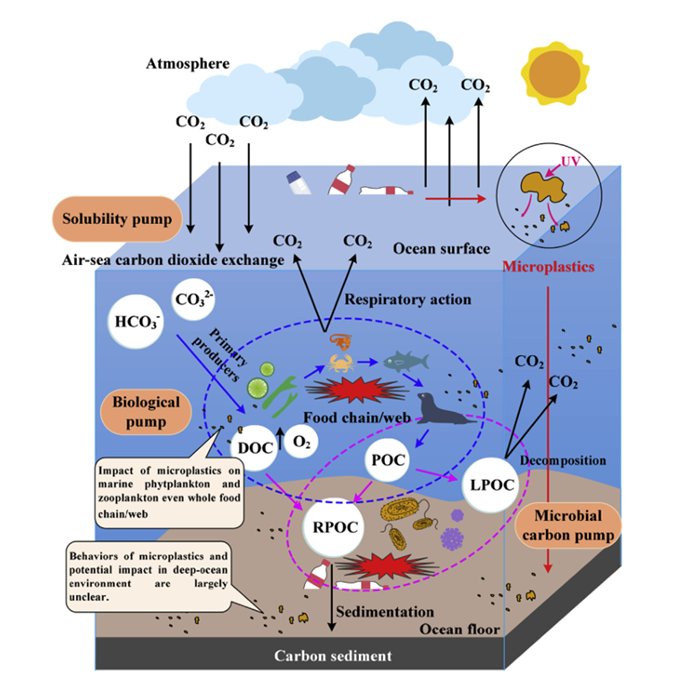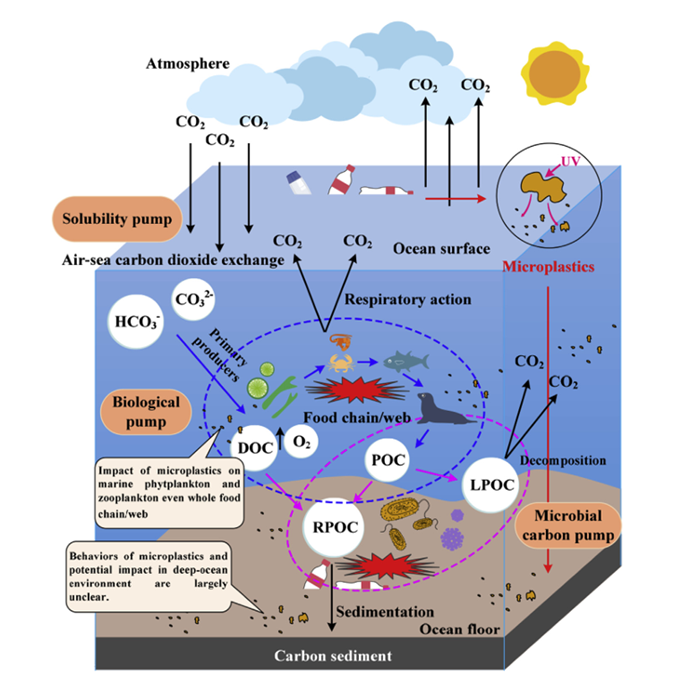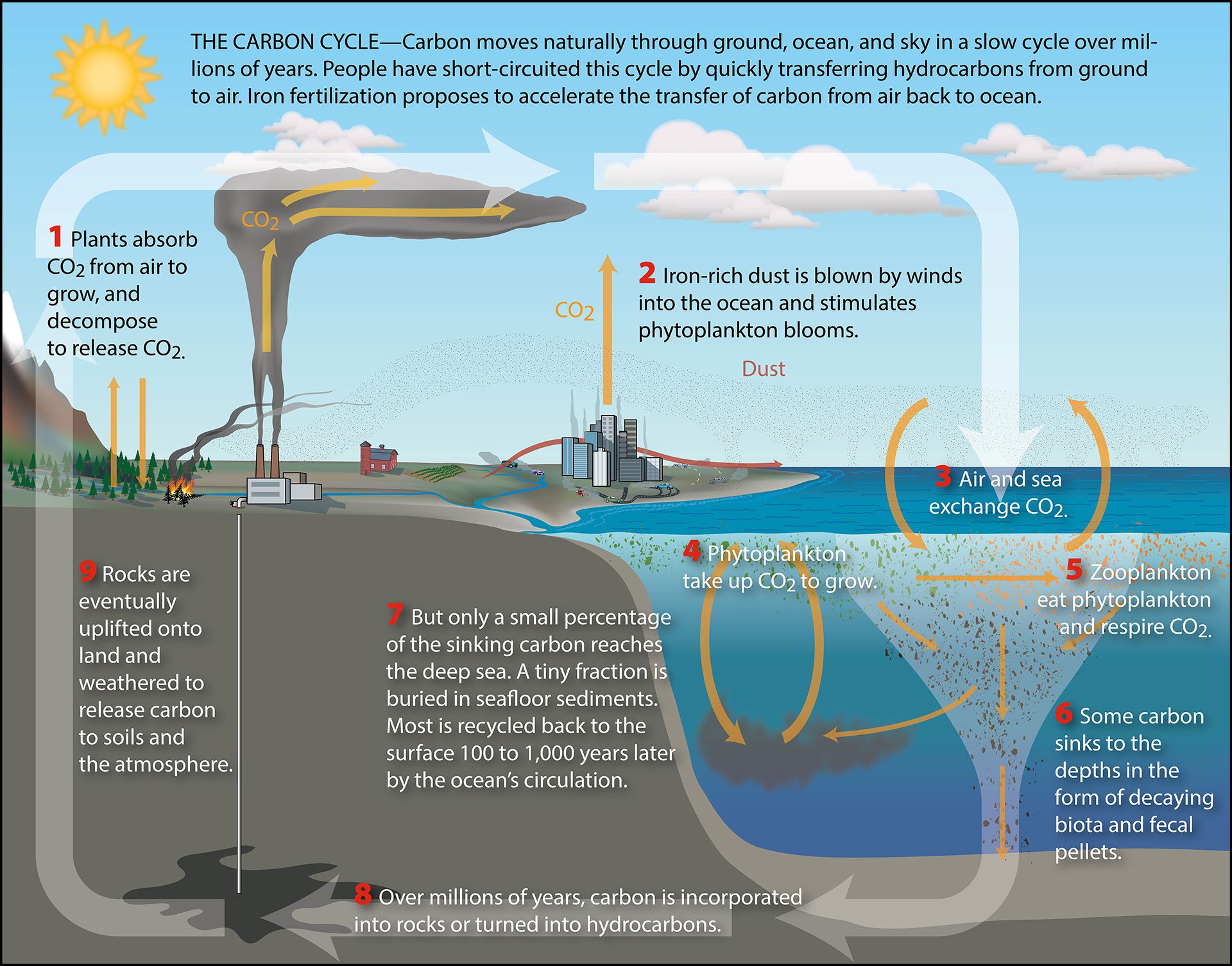How plastic waste in oceans affects carbon sequestration

The world's oceans play a crucial role in regulating the global carbon cycle, absorbing approximately 25% of the carbon dioxide released into the atmosphere. However, the increasing amount of plastic waste in the oceans is having a profound impact on this process. Plastic debris, including microplastics and macroplastics, is not only harming marine life but also affecting the ocean's ability to sequester carbon. As the plastic waste problem continues to grow, it is essential to understand the relationship between plastic pollution and carbon sequestration in the oceans to mitigate its effects on the global climate.
- Impact of Plastic Waste on Ocean's Carbon Sequestration Capacity
-
Understanding the Impact of Oceanic Plastic Waste on Global Carbon Sequestration Processes
- How do microplastics in oceans impact the global carbon sequestration process?
- Impact on Phytoplankton Communities
- Effects on Marine Sedimentation Processes
- Microbial Communities and Carbon Cycling
- How do oceans impact the global carbon cycle through sequestration processes?
- Physical Carbon Sequestration
- Biological Carbon Sequestration
- Ocean's Role in Long-term Carbon Storage
- How does rising ocean temperature impact the ocean's ability to absorb carbon dioxide?
- Impact on Solubility of CO2
- Effects on Ocean Stratification and Mixing
- Consequences for Marine Ecosystems and Carbon Cycling
- Frequently Asked Questions
Impact of Plastic Waste on Ocean's Carbon Sequestration Capacity
The presence of plastic waste in oceans has become a pressing concern globally, not just for its visible impact on marine life but also for its less obvious effects on the ocean's ability to sequester carbon. Oceans play a crucial role in the global carbon cycle, absorbing significant amounts of CO2 from the atmosphere. However, the increasing amount of plastic waste entering the oceans could potentially disrupt this process.
Effects on Phytoplankton
Phytoplankton are microscopic plants that live in the ocean and are crucial for the ocean's carbon sequestration process through photosynthesis, absorbing CO2 and producing organic carbon. Plastic waste, particularly microplastics, can be ingested by phytoplankton or affect their growth environment, potentially reducing their efficiency in carbon sequestration. For instance, microplastics can leach chemicals that are harmful to phytoplankton, thereby impacting their ability to perform photosynthesis effectively.
Alteration of Marine Ecosystems
The accumulation of plastic waste in oceans can lead to changes in marine ecosystems, affecting the biodiversity and composition of marine life. This can have a cascading effect on the ocean's carbon sequestration capabilities. For example, the death of marine organisms due to entanglement or ingestion of plastic debris can lead to an increase in organic matter sinking to the ocean floor, potentially altering the carbon sequestration process.
Impact on Ocean's Carbon Sink Capacity
The overall impact of plastic waste on the ocean's carbon sink capacity is a complex issue that involves understanding the interactions between plastic debris, marine life, and the carbon cycle. Research suggests that the presence of plastic waste could lead to a reduction in the ocean's ability to act as a carbon sink, exacerbating climate change. The effects are multifaceted and require comprehensive study to fully understand the implications.
| Impact Factor | Description | Effect on Carbon Sequestration |
|---|---|---|
| Microplastic Ingestion | Ingestion of microplastics by marine organisms | Reduces efficiency of phytoplankton in carbon sequestration |
| Ecosystem Alteration | Changes in marine ecosystems due to plastic waste | Impacts biodiversity and composition of marine life |
| Carbon Sink Capacity | Reduction in ocean's ability to sequester carbon | Exacerbates climate change |
Understanding the Impact of Oceanic Plastic Waste on Global Carbon Sequestration Processes
How do microplastics in oceans impact the global carbon sequestration process?

Microplastics in oceans have been found to impact the global carbon sequestration process in various ways. The presence of microplastics in marine environments can alter the biological processes that occur within the ocean, affecting the ability of marine ecosystems to sequester carbon.
Impact on Phytoplankton Communities
The presence of microplastics can impact phytoplankton communities, which are crucial for the ocean's carbon sequestration process. Phytoplankton absorb CO2 during photosynthesis, producing organic carbon that sinks to the ocean floor when they die. Microplastics can alter the species composition of phytoplankton communities, potentially reducing their overall productivity. Some of the effects include:
- Changes in phytoplankton community structure due to microplastic ingestion or entanglement
- Reduced growth rates or increased mortality of certain phytoplankton species
- Altered nutrient cycling patterns due to microplastic-associated microbial communities
Effects on Marine Sedimentation Processes
Microplastics can also influence marine sedimentation processes, which play a key role in the long-term sequestration of carbon. When microplastics are ingested by marine organisms, they can be incorporated into sinking particles, potentially altering the rate at which carbon is exported to the deep ocean. Some of the mechanisms by which microplastics affect sedimentation include:
- Aggregation of microplastics with sinking organic particles, enhancing their downward transport
- Incorporation of microplastics into fecal pellets or other biogenic aggregates
- Potential for microplastics to act as a 'vector' for the transport of organic carbon to the seafloor
Microbial Communities and Carbon Cycling
Microplastics can also impact microbial communities in the ocean, which are essential for the degradation and remineralization of organic matter. The presence of microplastics can lead to changes in microbial community composition and function, potentially influencing the rates at which organic carbon is broken down or stored. Some of the potential impacts include:
- Colonization of microplastics by distinct microbial communities with altered metabolic capabilities
- Stimulation or inhibition of microbial activity due to microplastic-associated chemicals or surfaces
- Potential for microplastics to influence the production or consumption of greenhouse gases, such as CO2 or CH4
How do oceans impact the global carbon cycle through sequestration processes?

Oceans play a crucial role in the global carbon cycle through various sequestration processes, acting as a significant carbon sink. The ocean's capacity to absorb and store carbon dioxide (CO2) from the atmosphere is a critical component in mitigating climate change. The process involves the exchange of CO2 between the atmosphere and the ocean's surface waters, followed by the transport of carbon to the deep ocean through various mechanisms.
Physical Carbon Sequestration
The physical process of carbon sequestration in oceans occurs through the dissolution of CO2 in seawater, forming carbonic acid, which then dissociates into bicarbonate and hydrogen ions. This process is influenced by factors such as ocean temperature, salinity, and circulation patterns.
- The solubility of CO2 in seawater decreases with increasing temperature, making colder waters more effective at absorbing CO2.
- Ocean circulation patterns, such as downwelling and upwelling, play a significant role in transporting carbon-rich waters to the deep ocean.
- The formation of sea ice also affects carbon sequestration by reducing the exchange of CO2 between the atmosphere and the ocean.
Biological Carbon Sequestration
Biological processes also contribute significantly to ocean carbon sequestration. Phytoplankton, through photosynthesis, convert CO2 into organic carbon, some of which sinks to the deep ocean as detritus or is consumed by organisms that eventually die and sink.
- Phytoplankton productivity is a key factor in determining the amount of carbon that is sequestered through biological processes.
- The sinking of organic matter to the deep ocean is influenced by factors such as the type of phytoplankton and the presence of grazers.
- Some organisms, like coccolithophores, produce calcium carbonate shells that can also contribute to carbon sequestration.
Ocean's Role in Long-term Carbon Storage
The ocean's role in long-term carbon storage is critical for regulating the global carbon cycle. The deep ocean stores carbon for centuries to millennia, making it a significant long-term carbon sink.
- The deep ocean's carbon storage capacity is influenced by factors such as ocean circulation, sedimentation rates, and the rate of organic matter decomposition.
- Some of the carbon stored in the deep ocean is eventually buried in sediments, providing a long-term carbon sink.
- The ocean's ability to store carbon over long periods helps regulate Earth's climate by reducing the amount of CO2 in the atmosphere.
How does rising ocean temperature impact the ocean's ability to absorb carbon dioxide?

Rising ocean temperature significantly impacts the ocean's ability to absorb carbon dioxide. As the ocean warms due to climate change, its capacity to act as a carbon sink is reduced. The ocean absorbs carbon dioxide from the atmosphere through various processes, including photosynthesis by phytoplankton and the simple dissolution of CO2 in seawater. However, as the temperature of the ocean's surface waters increases, the solubility of CO2 decreases, making it less effective at absorbing carbon dioxide from the atmosphere.
Impact on Solubility of CO2
The solubility of CO2 in seawater is directly affected by temperature. As the ocean warms, the solubility of CO2 decreases. This means that warmer ocean water is less capable of holding dissolved CO2, reducing the ocean's ability to absorb additional carbon dioxide from the atmosphere. The effects of decreased CO2 solubility due to rising ocean temperatures can be broken down into several key points:
- The solubility of gases in water generally decreases with increasing temperature.
- As a result, warmer waters hold less dissolved CO2.
- This reduction in CO2 solubility impacts the overall carbon sequestration potential of the ocean.
Effects on Ocean Stratification and Mixing
Rising ocean temperatures also affect ocean stratification and the mixing of surface and deeper waters. Warmer surface waters can lead to increased stratification, as the density difference between warmer surface waters and cooler deeper waters increases. This stratification can reduce the mixing of these water layers, potentially limiting the transport of carbon dioxide to deeper waters where it can be stored for longer periods. Key aspects of this process include:
- Increased stratification reduces the exchange between surface and deep waters.
- This can limit the effectiveness of the ocean's biological pump, which transports carbon to deeper waters through sinking organic matter.
- Reduced mixing affects nutrient availability for phytoplankton, potentially altering their productivity and the ocean's carbon uptake.
Consequences for Marine Ecosystems and Carbon Cycling
The impact of rising ocean temperatures on the ocean's ability to absorb CO2 has significant implications for marine ecosystems and carbon cycling. Changes in CO2 absorption can influence the pH levels of seawater, affecting marine life, especially organisms with calcium carbonate shells, such as corals and shellfish. Moreover, alterations in carbon cycling can have cascading effects on the entire marine food web. Some of the key considerations include:
- Ocean acidification due to increased CO2 levels can harm marine organisms, particularly those with calcium carbonate structures.
- Changes in phytoplankton productivity and community composition can affect the ocean's carbon sequestration potential.
- Impacts on marine ecosystems can have feedback effects on the global carbon cycle.
Frequently Asked Questions
What is the impact of plastic waste on ocean carbon sequestration?
Plastic waste in oceans affects carbon sequestration by altering the marine ecosystem's ability to absorb carbon dioxide. Plastic debris can entangle or suffocate marine life, reducing phytoplankton growth, which absorbs CO2 during photosynthesis. Additionally, plastic waste can also leach chemicals that harm marine organisms, further disrupting the ocean's carbon sink.
How does plastic pollution influence the ocean's carbon cycle?
Plastic pollution influences the ocean's carbon cycle by reducing the efficiency of marine carbon sinks. As plastic waste accumulates, it can block sunlight, hindering photosynthesis and decreasing the amount of organic matter that sinks to the ocean floor, taking carbon with it. This disrupts the ocean's natural carbon sequestration processes, potentially leading to increased atmospheric CO2 levels.
Can plastic waste in oceans lead to increased greenhouse gas emissions?
Yes, plastic waste in oceans can contribute to increased greenhouse gas emissions. As plastic breaks down, it releases methane and ethylene, potent greenhouse gases. Moreover, the degradation of plastic waste can also stimulate the release of stored carbon from sediments, further exacerbating climate change. This highlights the need to mitigate plastic pollution to maintain the ocean's carbon sequestration capacity.
What measures can be taken to mitigate the impact of plastic waste on ocean carbon sequestration?
To mitigate the impact of plastic waste on ocean carbon sequestration, reducing plastic pollution is crucial. Implementing policies to minimize single-use plastics, improving waste management infrastructure, and promoting recycling can help. Additionally, supporting research into plastic alternatives and ocean cleanup initiatives can also help to preserve the ocean's carbon sink and maintain its role in regulating the global climate.

Leave a Reply